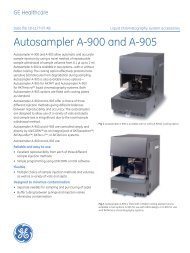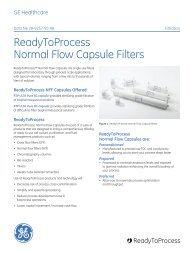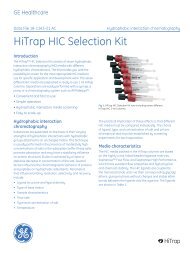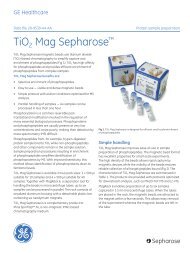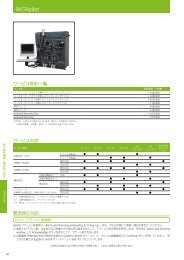[PDF] Data file : Ficoll PM 70, Ficoll PM 400
[PDF] Data file : Ficoll PM 70, Ficoll PM 400
[PDF] Data file : Ficoll PM 70, Ficoll PM 400
You also want an ePaper? Increase the reach of your titles
YUMPU automatically turns print PDFs into web optimized ePapers that Google loves.
GE Healthcare<br />
<strong>Data</strong> File 18-1158-27 AB Cell preparation<br />
<strong>Ficoll</strong> <strong>PM</strong><strong>70</strong><br />
<strong>Ficoll</strong> <strong>PM</strong><strong>400</strong><br />
<strong>Ficoll</strong> <strong>PM</strong><strong>70</strong> and <strong>Ficoll</strong> <strong>PM</strong><strong>400</strong> are high molecular weight<br />
sucrose-polymers formed by copolymerization of sucrose<br />
with epichlorohydrin. The molecules are highly branched<br />
and the high content of hydroxyl groups leads to very good<br />
solubility in aqueous media. <strong>Ficoll</strong> <strong>PM</strong><strong>70</strong> and <strong>PM</strong><strong>400</strong> are<br />
supplied as spray-dried powders. <strong>Ficoll</strong> products behave as<br />
ideal neutral spheres and have been proposed as the molecules<br />
of choice for studying pore size distribution and the<br />
permeability of membranes. <strong>Ficoll</strong> <strong>PM</strong><strong>70</strong> and <strong>Ficoll</strong> <strong>PM</strong><strong>400</strong><br />
have analogous structures, but differ in molecular weight, and<br />
are therefore appropriate for different research applications.<br />
Stability<br />
The stability of <strong>Ficoll</strong> products is chiefly determined by the<br />
glycosidic bonds in the sucrose residues. <strong>Ficoll</strong> products<br />
do not contain any ionized groups, so the structures do<br />
not react under physiological conditions. They are stable in<br />
alkaline and neutral solutions, but are rapidly hydrolyzed in<br />
solution at pH 3, especially at elevated temperature. <strong>Ficoll</strong><br />
products can be sterilized by autoclaving at 110ºC for<br />
30 min in neutral solutions. Strong oxidizing and reducing<br />
agents should be avoided. Shipping and storage are at<br />
ambient temperatures.<br />
Chemical and physical properties<br />
<strong>Ficoll</strong> products are provided as dry powder and are<br />
extremely hydrophilic. Solutions are best prepared by slowly<br />
stirring <strong>Ficoll</strong> powder into aqueous buffer. Gentle heating<br />
may be required for complete solubilization.<br />
<strong>Ficoll</strong> <strong>PM</strong><strong>70</strong> can be used at concentrations of up to 50%<br />
(w/v). Figure 2 shows the variation of viscosity of <strong>Ficoll</strong> <strong>PM</strong><strong>70</strong><br />
imagination at work<br />
Fig 1. <strong>Ficoll</strong> <strong>PM</strong><strong>70</strong> and <strong>Ficoll</strong> <strong>PM</strong><strong>400</strong>.<br />
ηrel<br />
50<br />
40<br />
30<br />
20<br />
10<br />
0<br />
0 5 10 15 20 25 30 35 40<br />
Concentration, w/v %<br />
Fig 2. Variation of viscocity with concentration for solutions of <strong>Ficoll</strong> <strong>PM</strong><strong>70</strong><br />
at 20ºC.<br />
with concentration at 20ºC. Note that the viscosity of a<br />
<strong>Ficoll</strong> <strong>PM</strong><strong>70</strong> solution is rather less than that of a solution<br />
of dextran (M r <strong>70</strong> 000) having the same osmotic pressure.<br />
Figure 3 shows the variation of osmolality with the<br />
concentration of <strong>Ficoll</strong> <strong>PM</strong><strong>70</strong>.
Osmolality, mOsm/kg H 2 O<br />
25<br />
20<br />
15<br />
10<br />
5<br />
0<br />
0 5 10 15<br />
Concentration, w/v %<br />
Fig 3. Variation of osmolality with concentration for solutions of <strong>Ficoll</strong> <strong>PM</strong><strong>70</strong><br />
at 25ºC.<br />
Density, g/ml<br />
1.200<br />
1.150<br />
1.100<br />
1.050<br />
Sucrose<br />
<strong>Ficoll</strong> product<br />
1.000<br />
0 10 20 30 40 50<br />
Concentration, w/v %<br />
Fig 4. Densities of <strong>Ficoll</strong> <strong>PM</strong><strong>400</strong> and sucrose solutions as a function of<br />
concentration.<br />
Relative viscosity, η r<br />
600<br />
500<br />
<strong>400</strong><br />
300<br />
200<br />
100<br />
0<br />
10 20 30 40 50<br />
Concentration, w/v %<br />
Fig 5. Relative viscosity (η r ) of <strong>Ficoll</strong> <strong>PM</strong><strong>400</strong> solutions at different<br />
concentrations.<br />
2 <strong>Data</strong> File 18-1158-27 AB<br />
With <strong>Ficoll</strong> <strong>PM</strong><strong>400</strong> one can also obtain concentrations of up<br />
to 50% (w/v) to cover a density range with a maximum of<br />
1.2 g/ml, without exceeding normal physiological osmolality.<br />
Figure 4 shows the comparable densities of solutions of<br />
<strong>Ficoll</strong> <strong>PM</strong><strong>400</strong> and sucrose as a function of concentration.<br />
Figure 5 shows the relative viscosity (η r ) at 20ºC of <strong>Ficoll</strong><br />
<strong>PM</strong><strong>400</strong> solutions at different concentrations.<br />
A<br />
B<br />
Osmolality, mOsm/kg H 2O<br />
Osmolality, mOsm/kg H 2O<br />
30<br />
25<br />
20<br />
15<br />
10<br />
5<br />
150<br />
125<br />
100<br />
0<br />
0 5 10 15<br />
Concentration, w/v %<br />
75<br />
50<br />
25<br />
0<br />
0 1 2 3 4 5<br />
Concentration, w/v %<br />
Fig 6. Variation of osmolality with concentration for solutions of<br />
(A) <strong>Ficoll</strong> <strong>PM</strong><strong>400</strong> and (B) sucrose at 25ºC.<br />
Solutions of <strong>Ficoll</strong> <strong>PM</strong><strong>400</strong> have much lower osmotic pressures<br />
than sucrose solutions at equivalent concentrations.<br />
Figures 6A and 6B show the variation of osmolality with<br />
concentration for <strong>Ficoll</strong> <strong>PM</strong><strong>400</strong> and sucrose respectively<br />
(note the considerable difference between the scales used<br />
in the two figures). The low osmolality of <strong>Ficoll</strong> products<br />
allows the formation of isotonic density gradients and<br />
preserves physiological and morphological integrity during<br />
centrifugation.<br />
You can estimate the concentration of both <strong>Ficoll</strong> <strong>PM</strong><strong>70</strong><br />
and <strong>Ficoll</strong> <strong>PM</strong><strong>400</strong> in aqueous solutions using the<br />
anthrone reaction (1).
<strong>Ficoll</strong> <strong>PM</strong><strong>70</strong><br />
• Displays minimal toxicity<br />
• Has favorable viscosity and osmotic properties (2)<br />
Description<br />
GE Healthcare produces a fraction of <strong>Ficoll</strong> product with an<br />
average molecular weight of <strong>70</strong> 000. This material, <strong>Ficoll</strong><br />
<strong>PM</strong><strong>70</strong>, is specifically intended for use in perfusion media for<br />
laboratory studies on dextran-sensitive animals.<br />
Technical data<br />
Molecular weight range ~ 6 × 104 to ~ 8 × 104 Intrinsic viscosity ~ 10 ml/g<br />
Specific rotation [α] 20 + 56.5º<br />
Stokes radius ~ 5.1 nm<br />
Cl - content < 1%<br />
Applications<br />
Laboratory studies of the circulation system in animals<br />
frequently involve the use of artificial perfusion solutions<br />
of well-defined characteristics. To provide a suitable colloid<br />
osmotic pressure during the experiment, a high molecular<br />
weight polymer, frequently dextran, is added to the solution.<br />
The use of dextran for perfusion studies on rats is, however,<br />
not practically possible since infusion of dextran solutions<br />
produces anaphylactoid-like reactions in these animals (3).<br />
<strong>Ficoll</strong> <strong>PM</strong><strong>70</strong> has been specifically produced to make possible<br />
perfusion experiments using dextran-sensitive animals.<br />
Studies of the circulation in spontaneously hypertensive and<br />
normotensive rats using this technique have been reported<br />
by Folkow et al (4–8). A 4% (w/v) solution of <strong>Ficoll</strong> <strong>PM</strong><strong>70</strong><br />
was used to provide a normal colloid osmotic pressure<br />
(7) and both whole animal (4) and isolated hindquarter<br />
preparations (5) were used. The results of these experiments<br />
have provided evidence for morphological adaptations of<br />
the resistance vessels of the systemic circuit in hypertensive<br />
rats (4,5) which may be sufficient to account for their<br />
increased flow resistance during rest.<br />
<strong>Ficoll</strong> <strong>PM</strong><strong>70</strong> has also proved valuable for cell isolation by unit<br />
gravity sedimentation (9).<br />
<strong>Ficoll</strong> <strong>PM</strong><strong>400</strong><br />
• Gives density range with a maximum of 1.2 g/ml,<br />
allowing the isolation of many types of cells and<br />
organelles (see Table 1).<br />
• Has lower osmotic pressures than sucrose solutions<br />
of equal density, resulting in better preservation of<br />
the functional and morphological integrity of cells<br />
and organelles.<br />
Description<br />
In a variety of research situations inert, non ionized polymers<br />
of high molecular weight are needed. <strong>Ficoll</strong> <strong>PM</strong><strong>400</strong>, is a<br />
synthetic neutral, highly-branched hydrophilic polymer of<br />
sucrose with an average molecular weight of <strong>400</strong> 000. It<br />
has long been used in the formation of density gradients<br />
for the separation and isolation of eukaryotic cells,<br />
organelles, and bacterial cells, as a stabilizing agent and<br />
as a separation medium for the isolation of lymphocytes. It<br />
also has applications in defined culture media, nucleic acid<br />
hybridization, electrophoresis, and immunological studies.<br />
The favorable osmotic, density, and viscosity characteristics<br />
of <strong>Ficoll</strong> <strong>PM</strong><strong>400</strong> make it an excellent choice for many<br />
applications.<br />
Because of its high molecular weight (~ <strong>400</strong> 000) and<br />
low content of dialyzable material, <strong>Ficoll</strong> <strong>PM</strong><strong>400</strong> does not<br />
normally penetrate biological membranes.<br />
Technical data<br />
Molecular weight range ~ 3 × 105 to ~ 5 × 105 Intrinsic viscosity ~ 17 ml/g<br />
Specific rotation [α] 20 + 56.5º<br />
Stokes radius ~ 10 nm<br />
Cl - content < 1%<br />
Applications<br />
Centrifugation<br />
In centrifugation methods, the density and viscosity of<br />
the medium are adjusted to allow particle sedimentation<br />
with a convenient speed. With sucrose, the high osmotic<br />
pressure, which results from the concentrations used, often<br />
damages the cells. If instead you add a high molecular<br />
weight polymer such as <strong>Ficoll</strong> product, you obtain the<br />
required density without significantly increasing the osmotic<br />
pressure. This preserves cells intact and retains their<br />
viability. <strong>Ficoll</strong> product is therefore preferred to sucrose for<br />
forming density gradients, and is primarily used in this way<br />
for the routine separation of cells (10, 11, 12)<br />
<strong>Ficoll</strong> <strong>PM</strong><strong>400</strong> can be used for gradient centrifugation in all<br />
types of centrifuge rotors and for separation at unit gravity.<br />
For centrifugation, both discontinuous and continuous<br />
gradients are possible. Discontinuous gradients offer two<br />
main advantages: First, the abrupt changes in <strong>Ficoll</strong> <strong>PM</strong><strong>400</strong><br />
density mean that isolated cells are found in sharp bands at<br />
the interface between layers of different density. This allows<br />
for easy removal of the purified sample with a pipette.<br />
<strong>Data</strong> File 18-1158-27 AB 3
Second, cells with great differences in density can easily be<br />
isolated with as few as two density layers. This is achieved<br />
by choosing densities that will prevent one or more type of<br />
cell from entering the lower phase, banding these cell types<br />
at the interface. To estimate the densities required for a<br />
particular application, refer to Table 1.<br />
Discontinuous gradients are established as follows:<br />
1. Using Table 1 as a guide, dissolve <strong>Ficoll</strong> <strong>PM</strong><strong>400</strong> in buffer or<br />
isotonic (0.25 M) sucrose solution at various concentrations<br />
(generally differing by 5 to 10% w/v), which should<br />
separate the cells of interest. Most cells and organelles<br />
have a buoyant density between 1.0 and 1.2 g/ml in<br />
<strong>Ficoll</strong> <strong>PM</strong><strong>400</strong>. Often, a simple two-layer gradient is<br />
sufficient. You may store these fractions in a refrigerator,<br />
but ensure that they reach room temperature before use.<br />
2. In normal centrifuge tubes, make layers (approx. 1-cm<br />
deep) of decreasing density with the most dense solution<br />
at the bottom.<br />
3. Keep the tubes at room temperature for a few hours to<br />
allow diffusion across the interfaces, and thereby even<br />
out the sharp borders between fractions.<br />
4. Layer the suspension to be fractionated carefully on top.<br />
Stir the sample and upper <strong>Ficoll</strong> product layer gently<br />
with a glass rod to eliminate the interface between them<br />
before centrifugation.<br />
During centrifugation, particles collect either in or between<br />
the various <strong>Ficoll</strong> product layers, depending on the density<br />
of the layers. The cells/organelles collect at a lower density<br />
than on sucrose gradients of equivalent concentration, as<br />
<strong>Ficoll</strong> product does not penetrate cell membranes. After<br />
centrifugation, pipette off the various phases, and remove<br />
the <strong>Ficoll</strong> product from the required fraction by repeatedly<br />
diluting with buffer, and centrifuging to sediment the<br />
particles. Residual amounts of <strong>Ficoll</strong> <strong>PM</strong><strong>400</strong> in the sample<br />
can be estimated with the anthrone reaction (1).<br />
As an alternative to discontinuous gradients, you can<br />
easily prepare a continuous or linear density gradient of<br />
<strong>Ficoll</strong> product using a gradient mixer (13). In simple cases,<br />
you may only need one homogeneous solution (i.e., no<br />
density gradient). You can then fractionate by increasing<br />
centrifugation speed in steps. <strong>Ficoll</strong> <strong>PM</strong><strong>400</strong> has also been<br />
employed in zonal centrifugation studies (14).<br />
Unit gravity sedimentation through a density gradient is<br />
widely used to separate cells intolerant to centrifugation<br />
(15). <strong>Ficoll</strong> <strong>PM</strong><strong>400</strong> provides an economical alternative to<br />
albumin in such applications. Cells with similar densities<br />
but different size can also be efficiently separated at unit<br />
gravity (16, 17, 18). <strong>Ficoll</strong> <strong>PM</strong><strong>70</strong> has also been used, giving<br />
gradients of suitable osmolality yet very low viscosity (9).<br />
Cell isolation<br />
Isolation and purification of various cell types, organelles,<br />
protoplasts, cytoplasts, liposomes, minicells, bacterial cells<br />
and viruses can be accomplished on gradients of <strong>Ficoll</strong> <strong>PM</strong><strong>400</strong><br />
(19, 20, 21, 22, 23).<br />
4 <strong>Data</strong> File 18-1158-27 AB<br />
Table 1. Examples of cells, viruses and subcellular particles separated in<br />
<strong>Ficoll</strong> <strong>PM</strong><strong>400</strong> a .<br />
Source Densityb Conditions<br />
Membranes 1.05 100 000 × g for 16 h<br />
Chromatophores 1.07 195 000 × g for 36 h<br />
Brain vesicles - 21 000 × g for 15 min<br />
Hepatocyte cells 1.10–1.15 6000 × g for 2 h<br />
Fibroblast cells 1.05 8000 × g for 60 min<br />
Ehrlich ascites cells 1.07 1<strong>400</strong> × g for 45 min<br />
a = <strong>Data</strong> adapted from Centrifugation: a practical approach, D. Rickwood (ed.), IRLpress (Oxford and<br />
Washington D.C.) (1984).<br />
b = Density is given as buoyant density.<br />
Chemically defined cell culture media<br />
<strong>Ficoll</strong> <strong>PM</strong><strong>400</strong> is used with and without serum-derived<br />
growth factors to support the growth of both primary<br />
cultures and established cell lines (24, 25).<br />
Concentration dialysis<br />
<strong>Ficoll</strong> <strong>PM</strong><strong>400</strong> is useful for concentrating solutions by<br />
dialysis since its high molecular weight and low content<br />
of dialyzable material prevents it crossing the dialysis<br />
membrane. Osmotic pressure draws water across the<br />
membrane into the solution of <strong>Ficoll</strong> <strong>PM</strong><strong>400</strong>, effectively<br />
concentrating sensitive materials.<br />
Electrophoresis<br />
Continuous flow electrophoresis usually requires a stabilizer<br />
in the electrolyte. <strong>Ficoll</strong> <strong>PM</strong><strong>400</strong> is often employed in this<br />
capacity (26, 27).<br />
Immunological studies<br />
<strong>Ficoll</strong> <strong>PM</strong><strong>400</strong> can be employed as a hapten carrier, and<br />
has been conjugated to DNP, TNP, and FITC for the purpose<br />
of enhancing the primary immune response in mice.<br />
Conjugates with a range of substitution levels and minimal<br />
toxicity are easily prepared (28, 29, 30, 31).<br />
Lymphocyte isolation<br />
For routine separation of lymphocytes, we recommend<br />
<strong>Ficoll</strong>-Paque PLUS or <strong>Ficoll</strong>-Paque PREMIUM (32, 33).<br />
These are sterile, ready to use media of density 1.077 g/ml;<br />
they contain <strong>Ficoll</strong> <strong>PM</strong><strong>400</strong> (5.7% w/v) and sodium diatrizoate<br />
(9.0% w/v).<br />
Lysis and cell particle isolation<br />
Isotonic solutions and density gradients of <strong>Ficoll</strong> products<br />
are widely used to lyse protoplasts, and extract or isolate<br />
cell particles (19, 20, 21, 22, 23).<br />
Molecular stabilization<br />
<strong>Ficoll</strong> <strong>PM</strong><strong>400</strong> has been used as s cryoprotective agent for<br />
unstable biomacromolecules, as well as its cryprotective<br />
properties, <strong>Ficoll</strong> <strong>PM</strong><strong>400</strong> has also been found to greatly<br />
contribute to the stabilization of sensitive macromolecules<br />
both in solution and during vacuum drying.
Nucleic acid hybridization<br />
A common application has been the use of <strong>Ficoll</strong> <strong>PM</strong><strong>400</strong> in<br />
Northern and Southern blot analysis. <strong>Ficoll</strong> <strong>PM</strong><strong>400</strong> (0.02%),<br />
as a constituent in Denhardts solution, reduces non-specific<br />
binding of material to nitrocellulose membranes during<br />
nucleic acid hybridization (34, 35, 36).<br />
Phase partitioning<br />
Phase partitioning separates cells on the basis of surface<br />
properties. <strong>Ficoll</strong> <strong>PM</strong><strong>400</strong> is combined with polyethylene<br />
glycol in two-phase systems, and with dextran and<br />
polyethylene glycol in three-phase systems (37, 38).<br />
Protein quantitation<br />
An improved <strong>Ficoll</strong> <strong>PM</strong><strong>400</strong> density gradient method has<br />
been described for the correct determination of the protein<br />
content of crystals (39).<br />
References<br />
1. Scott. T.A. and Melvin, E.H. Determination of dextran with anthrone. Anal. Chem.,<br />
25 1656–1661 (1953).<br />
2. Folkow, B. et al. The hemodynamic consequences of regional hypotension in<br />
spontaneously hypertensive and normotensive rats. Acta Physio. Scand., 83<br />
532–541(1971).<br />
3. Morrison, J.L., Bloom, W.L., Richardson, A.P. J. Effect of dextran on the rat.<br />
Pharmacol. Exp. Therap. 101 27–28 (1951).<br />
4. Folkow, B., Hallbäck, M., Lundgren, Y. et al. Structurally based increase of flow<br />
resistance of spontaneously hypertensive rats. Acta Physiol. Scand. 79 (19<strong>70</strong>).<br />
5. Folkow, B., Hallbäck, M., Lundgren Y. et al. Background of increased flow<br />
resistance and vascular reactivity in spontaneously hypertensive rats. Acta<br />
Physiol. Scand. 80 93–106 (19<strong>70</strong>).<br />
6. Folkow, B., Hallbäck, M., Lundgren Y. et al. Renal vascular resistance in<br />
spontaneously hypertensive rats. Acta Physiol. Scand. 83 96–105 (1971).<br />
7. Folkow, B., Gurèvich, M., Lundgren Y. et al. The hemodynamic consequences of<br />
regional hypotension in spontaneously hypertensive and normotensive rats. Acta<br />
Physiol. Scand. 83 532–541(1971).<br />
8. Folkow, B., Hallbäck, M., Lundgren Y. et al. The effects of “immunosympathectomy”<br />
on blood pressure and vascular “reactivity” in normal and spontaneously<br />
hypertensive rats. Acta Physiol. Scand. 84 512–523 (1972).<br />
9. De Vries, J.E. et al. Abstracts, 4th European Immunology Meeting, Budapest,<br />
April 1978.<br />
10. Böyum, A. A one stage procedure for isolation of granulocytes and lymphocytes<br />
from human blood. Scand. J. clin. Lab. Invest., 21 51–76 (1968).<br />
11. Battistuzzi, G. et al. Tissue specific levels of human glucose-6-phosphate<br />
dehydrogenase correlate with methylation of specific sites at the 3´ end of the<br />
gene. Proc. Natl. Acad. Sci. U.S.A., 82 1465-1469 (1985).<br />
12. Leopardi, E. and Rosenau, W. Human t-cell mediated cytotoxicity: role of subsets<br />
and neutralization of cytotoxicity by anti-a-lymphotoxin serum. Cell. Immunol.,<br />
<strong>70</strong> 148–159 (1982).<br />
13. Rola-Pleszczynski, M. and Churchill, W.H. Purification of human monocytes by<br />
continuous gradient sedimentation in <strong>Ficoll</strong>. J. Immunol. Methods, 20 255–262<br />
(1978).<br />
14. Lavrenko, P.N., Mikriukova, O.I., and Okatova, O.V., On the separation of various<br />
<strong>Ficoll</strong> gradient solutions in zonal centrifugation. Anal. Biochem. 166, 287 (1987).<br />
15. Immunological characterization of FcR bearing and non-bearing B cells:<br />
Functional modification of immune complexes. Park, Y-H. et al. Cell. Immunol., 83<br />
340–350 (1984).<br />
16. Tulp, A., et al., An improved Method for the Separation of Cells by Sedimentation<br />
at Unit Gravity. Anal. Biochem. 67, 11 (1975).<br />
17. Niskanen, E., et al. Separation by velocity sedimentation of human haemopoietic<br />
precursors forming colonies in vivo and in vitro cultures. Cell tissue Kinet. 18, 399<br />
(1985).<br />
18. Bont, W.S., et al, Separation of human lymphocytes and monocytes by velocity<br />
sedimentation at unit gravity. J. Immunol. Methods 29, 1 (1979).<br />
19. Low, F-C. and Wiemken, A. Fractionation of Hevea brasiliensis latex on <strong>Ficoll</strong><br />
density gradients. Phytochem., 23 747–750 (1984).<br />
20. Moeller, C.H. et al. Lipid phase separations and intramembranous particle<br />
movements in the yeast tonoplast. Biochim. Biophys. Acta, 643 376–386 (1981).<br />
21. Gennaro, R. et al. Monitoring of cytosolic free Ca2+ in C5a -stimulated neutrophils:<br />
Loss of receptormodulated Ca2+ stores and Ca2+ uptake in granule-free<br />
cytoplasts. Proc. Natl. Acad. U.S.A., 81 1416–1420 (1984).<br />
22. Elliot, B.E. et al. Receptor specificity of Ia-restricted T lymphoblasts activated<br />
against trinitrobenzene sulphonate-coupled spleen cells: recognition of distinct<br />
trinitrophenyl and Ia moieties. Cell. Immunol., 121–137 (1984).<br />
23. Sindhy, R.K. and Cohen, S.S. Subcellular localization of spermidine synthetase in<br />
the protoplasts of chinese cabbage leaves. Plant Physiol., 219–223 (1984).<br />
24. Clark, J. In Hormonally Defined Media, Lecture Posters Eur. Conf. Serum-Free Cell<br />
Culture, Fischer, G. and Wieser, R.J. (eds), Springer (Berlin), 6, (1983).<br />
25. Kao, K.N., Plant formation from Barley Anther cultures with <strong>Ficoll</strong> media. Z.<br />
Pflanzenphysiol Bd. 103, 437 (1981).<br />
26. Platsoucas, C.D., and Catsimpoolas, N., Density gradient electrophoresis of<br />
mouse spleen lymphocytes: age-related differences. A critical thymus-dependent<br />
event during development in the young mouse. J, Immunol. Methods 34, 31<br />
(1980).<br />
27. Platsoucas, C.D., Good, R.A., and Gupta, S., Separation of human lymphocyte<br />
subpopulations by density gradient electrophoresis. Cell. Immunol. 51, 238 (1980).<br />
28. McMasters, P.R.B. et al., The preparation and characterization of thymic<br />
independent antigen e-dinitrophenyl-Llysine-<strong>Ficoll</strong>. Immunochemistry 14, 189, (1977).<br />
29. Inman, J.K., Thymus independent antigens: the preparation of covalent, hapten-<br />
<strong>Ficoll</strong> conjugates. J. Immunol. 114, <strong>70</strong>4 (1975).<br />
30. IgD secreting Physiology of IgD. IV. Enhancement of antibody production if mice<br />
bearing plasmacytomas. Xue, B. et al. J. Exp. Med., 159 103-113 (1984).<br />
31. DeHeer, D.H. and Edgington, R.S. Relationship between antibody affinity and<br />
hemolytic plaque diameter-II. Maturation of primary immune responses to DNP<br />
and SRBC.Mol. Immunol., 17 1231–1236 (1980).<br />
32. Carlsson, R. et al. Staphylococcal Protein A (Sp A) does not induce production of<br />
interferon-g in human mononuclear blood cells. Cell. Immunol., 86 136–144 (1984).<br />
33. “<strong>Ficoll</strong>-Paque for in vitro isolation of lymphocytes” (art. no. 18-1152-69).<br />
34. Medveczky, P. et al. Classification of Herpes virus Saimiri into three groups based<br />
on extreme variation in a DNA region required for oncogenicity. J. Virol., 52<br />
938–944 (1984).<br />
35. Virtanen, A. et al. mRNAs from human Adenovirus 2 early region 4. J. Virol., 51<br />
822–831(1984).<br />
36. Holland. L.E. et al. Transcriptional and genetic analyses of the herpes simplex<br />
virus type 1 genome: co-ordinates 0.29 to 0.45. J. Virol, 49 947–959 (1984).<br />
37. Johansson, G., and Joelsson, M., J. Partition of the hydrophobic compounds<br />
between two liquid phases of similar hydrophobicity. Chromatog. 464, 49 (1989).<br />
38. Albertsson, P.A., and Birkenmeier, G., Affintiy Separation of Proteins in Aqueous<br />
Three-Phase Systems. Anal. Biotech. 175, 154 (1988).<br />
39. Bode. W. and Schirmer, Determination of the protein content of crystals formed<br />
by Mastigocladus laminosus c-Phycocyanin, Chroomonas spec. Phytocyanin-<br />
645 and modified human fibronogen using an improved <strong>Ficoll</strong> density gradient<br />
method. T. Biol. Chem., 366 287–295 (1985).<br />
Additional references by subject<br />
Purification/isolation of:<br />
Protein crystals<br />
Bode, W., and Schirmer, T., Determination of the Protein Content of Crystals Formed<br />
by Mastigocladus laminosus CPhycocyanin, Chroomonas spec. Phycocyanin-645 and<br />
Modified Human Fibrinogen Using an Improved <strong>Ficoll</strong> Density Gradient Method. Biol.<br />
Chem. Hoppe-Seyler 366, 287 (1985).<br />
Murine bone marrow cells<br />
Schneider, E., et al., Histamine-Producing Cell-Stimulating Activity. J. Immunol. 139,<br />
3810 (1987).<br />
Cell membranes<br />
Zafra, F., and Gimenez, D., Characterization of Glycine Uptake in Plasma Membrane<br />
Vesicles Isolated from Cultured Glioblastoma Cells. Brain Research 297, 108 (1986).<br />
Plant protoplasts<br />
Attree, S.M., and Sheffield, E., An evaluation of <strong>Ficoll</strong> density gradient centrifugation<br />
as a method for eliminating microbial contamination and purifying plant protoplasts.<br />
Plant Cell Reports 5, 288 (1986).<br />
Cytoplasts<br />
Volloch, V., Schweitzer, B., and Rits, S., Synthesis of Globin RNA in Enucleated<br />
Diofferentiating Murine Erythroleukemia Cells. J. Cell Biol. 105, 137 (1987).<br />
Endonucleobionts from host<br />
Characterization of Caedibacter Endonucleobionts from the Macronucleous of<br />
Paramecium caudatum and the Identification of a Mutant with Blocked R-Body<br />
Synthesis. Schmidt, H.J., et al., Exp. Cell Res. 174, 817 (1988).<br />
<strong>Data</strong> File 18-1158-27 AB 5
Plant cells<br />
Takeda, J., et al., Membrane Potential of Cultured Carrot Cells in Relation to the<br />
Synthesis of Anthocyanin and Embryogenesis. Plant Cell Physiol. 29, 817 (1988).<br />
Rod outer segment disk membranes<br />
Bauer, P.J., and Mavrommati, E., Permeability of Rod Outer Segment Disk Membranes<br />
as Probed by <strong>Ficoll</strong> Density Gradient Centrifugation and by Turbidimetry. Expt. Eye Res.<br />
42, 255 (1986).<br />
Proteoliposomes from uncoupled protein aggregates<br />
Shrishailam, Y., et al., Selective killing of T lymphocytes by phototoxic liposomes. Proc.<br />
Nat. Acad. Sci. USA 84, 246 (1987).<br />
Human sperm<br />
Kaneko, S., and Moriwaki, C., Effects of Kinins and Dipeptidyl Carboxypeptidase on the<br />
Motility of Highly Washed Human Sperm. J., Pharm. Dyn. 4, 443 (1981).<br />
Vacoules of the yeast tonoplast<br />
Moeller, C.H., Mudd, J., and Thomson, W.W., Lipid Phase Separations and<br />
Intramembranous Particle Movements in the Yeast Tonoplast. Biochim. Biophys. Acta<br />
643, 376 (1981).<br />
Pancreatic islet cells<br />
Gotoh, M., et al., Immunological Characteristics of Purified Pancreatic Islet Grafts.<br />
Transplantation 42, 387 (1986).<br />
Other applications:<br />
Virus binding studies<br />
Haywood, A.M., and Boyer, B.P., <strong>Ficoll</strong> and Dextran Enhance Adhesion of Sendai Virus to<br />
Liposomes Containing Receptor (Ganglioside GD1a). Biochemistry 25, 3925 (1986).<br />
Preparation of cytoplasts<br />
Malawista, S.E., Van Blaricom, G., and Breitenstein, M.G., Cryopreservable Neutrophil<br />
Surrogates. J. Clin. Investigation 83, 728 (1989).<br />
Generation of minicells<br />
Stieglitz, H., et al., Cloning, Sequencing, and Expression in <strong>Ficoll</strong>-Generated Minicells of<br />
an Escherichia coli Heat-Stable Enterotoxin Gene. Plasmid 20, 42 (1988).<br />
Stabilizer for rapid freezing<br />
Furuya S., Edwards, C., and Ornberg, R.L. Exocystosis of Bovine Chromaffin Granules in<br />
<strong>Ficoll</strong> Captured by Rapid Freezing. J. Electron Microsc. 38, 143 (1989).<br />
www.gehealthcare.com/cellprep<br />
GE Healthcare Bio-Sciences AB<br />
Björkgatan 30<br />
751 84 Uppsala<br />
Sweden<br />
imagination at work<br />
<strong>Ficoll</strong> <strong>PM</strong><strong>70</strong> and <strong>Ficoll</strong> <strong>PM</strong><strong>400</strong> are supplied as dry powders in<br />
the following pack sizes:<br />
Ordering information<br />
Product Pack size Code no.<br />
<strong>Ficoll</strong> <strong>PM</strong><strong>70</strong> 100 g 17-0310-10<br />
500 g 17-0310-50<br />
5 kg 17-0310-05<br />
<strong>Ficoll</strong> <strong>PM</strong><strong>400</strong> 100 g 17-0300-10<br />
500 g 17-0300-50<br />
5 kg 17-0300-05<br />
40 kg 17-0300-08<br />
Related products<br />
<strong>Ficoll</strong>-Paque PLUS 6 x 100 ml 17-1440-02<br />
6 x 500 ml 17-1440-03<br />
<strong>Ficoll</strong>-Paque PREMIUM 6 x 100 ml 17-5442-02<br />
6 x 500 ml 17-5442-03<br />
Percoll PLUS 250 ml 17-5445-02<br />
1 l 17-5445-01<br />
Percoll 250 ml 17-0891-02<br />
1 l 17-0891-01<br />
GE, imagination at work and GE Monogram are trademarks of General<br />
Electric Company.<br />
<strong>Ficoll</strong>-Paque, <strong>Ficoll</strong> and Percoll are trademarks of GE Healthcare companies.<br />
Percoll PLUS is protected by the following patents and equivalent patents and<br />
patent applications in other countries, which are licensed to GE Healthcare<br />
from Dendreon Corporation: US patent number 4,927,749, US patent number<br />
4,927,750, Canadian patent number 1,338,492, Japanese patent number<br />
2,628,509, US patent number 5,789,148, US patent number 6,015,843 and<br />
European patent number 1,047,635. A free, non-transferable license to use this<br />
product for density gradient separation purposes under the above mentioned<br />
patent rights accompanies the purchase of the product from a GE Healthcare<br />
company and its licensed distributors, but any use of Percoll PLUS or any other<br />
organosilanized colloidal silica particle-based separation media to enrich,<br />
purge or isolate cells for active immunotherapy for oncology applications shall<br />
be excluded from such license.<br />
© 2001–2007 General Electric Company – All rights reserved.<br />
First published Nov. 2001<br />
All goods and services are sold subject to the terms and conditions of<br />
sale of the company within GE Healthcare which supplies them. A copy of<br />
these terms and conditions is available on request. Contact your local GE<br />
Healthcare representative for the most current information.<br />
GE Healthcare Europe GmbH<br />
Munzinger Strasse 5, D-79111 Freiburg, Germany<br />
GE Healthcare UK Ltd<br />
Amersham Place, Little Chalfont, Buckinghamshire, HP7 9NA, UK<br />
GE Healthcare Bio-Sciences Corp<br />
800 Centennial Avenue, P.O. Box 1327, Piscataway,<br />
NJ 08855-1327, USA<br />
GE Healthcare Bio-Sciences KK<br />
Sanken Bldg. 3-25-1, Hyakunincho, Shinjuku-ku,<br />
Tokyo 169-0073, Japan<br />
Asia Pacific T +85 65 62751830 F +85 65 62751829 • Australasia T +61 2 8820 8299 F +61 2 8820 8200 • Austria T 01 /57606 1613 F 01 /57606 1614 • Belgium T 0800 73 890 F 02 416 8206 • Canada T 1 800 463 5800 F 1 800 567 1008 • Central<br />
& East Europe T +43 1 972 720 F +43 1 972 722 750 • Denmark T +45 <strong>70</strong> 25 24 50 F +45 45 16 2424 • Eire T 1 800 <strong>70</strong>9992 F +44 1494 542010 • Finland & Baltics T +358 9 512 3940 F +358 9 512 39439 • France T 01 69 35 67 00 F 01 69 41 98 77<br />
Germany T 0800 9080 711 F 0800 9080 712 • Greater China T +852 2100 6300 F +852 2100 6338 • Italy T 02 26001 320 F 02 26001 399 • Japan T 81 3 5331 9336 F 81 3 5331 93<strong>70</strong> • Korea T 82 2 6201 3<strong>70</strong>0 F 82 2 6201 3803 • Latin America T +55 11 3933 7300<br />
F +55 11 3933 7304 • Middle East & Africa T +30 210 96 00 687 F +30 210 96 00 693 • Netherlands T 0800-82 82 82 1 F 0800-82 82 82 4 • Norway T +47 815 65 777 F +47 815 65 666 • Portugal T 21 417 <strong>70</strong>35 F 21 417 3184 • Russia, CIS & NIS<br />
T +7 495 956 5177 F +7 495 956 5176 • Spain T 902 11 72 65 F 935 94 49 65 • Sweden T 018 612 1900 F 018 612 1910 • Switzerland T 0848 8028 10 F 0848 8028 11 • UK T 0800 515 313 F 0800 616 927 • USA T +1 800 526 3593 F +1 877 295 8102<br />
18-1158-27 AB 02/2007


![[PDF] Data file : Ficoll PM 70, Ficoll PM 400](https://img.yumpu.com/6668892/1/500x640/pdf-data-file-ficoll-pm-70-ficoll-pm-400.jpg)
![[PDF] マニュアル GradiFrac](https://img.yumpu.com/22037825/1/190x253/pdf-gradifrac.jpg?quality=85)
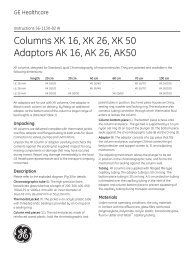
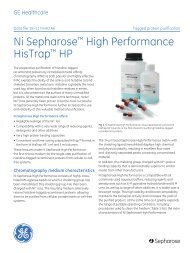
![[PDF] Sample preparation for analysis of protein, peptides and ...](https://img.yumpu.com/21549715/1/190x257/pdf-sample-preparation-for-analysis-of-protein-peptides-and-.jpg?quality=85)
![[PDF] Data File: rProtein A Sepharose Fast Flow](https://img.yumpu.com/21549316/1/190x253/pdf-data-file-rprotein-a-sepharose-fast-flow.jpg?quality=85)
![[PDF] MBP-tagged protein purification](https://img.yumpu.com/21548507/1/184x260/pdf-mbp-tagged-protein-purification.jpg?quality=85)
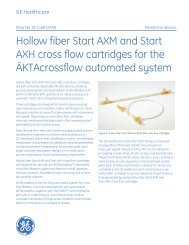
![[PDF] AKTA ready system Data file](https://img.yumpu.com/21540925/1/190x253/pdf-akta-ready-system-data-file.jpg?quality=85)
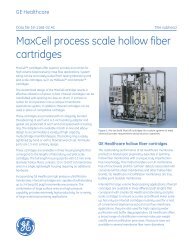
![[PDF] Data File - rProtein A/Protein G GraviTrap](https://img.yumpu.com/21539052/1/190x253/pdf-data-file-rprotein-a-protein-g-gravitrap.jpg?quality=85)
